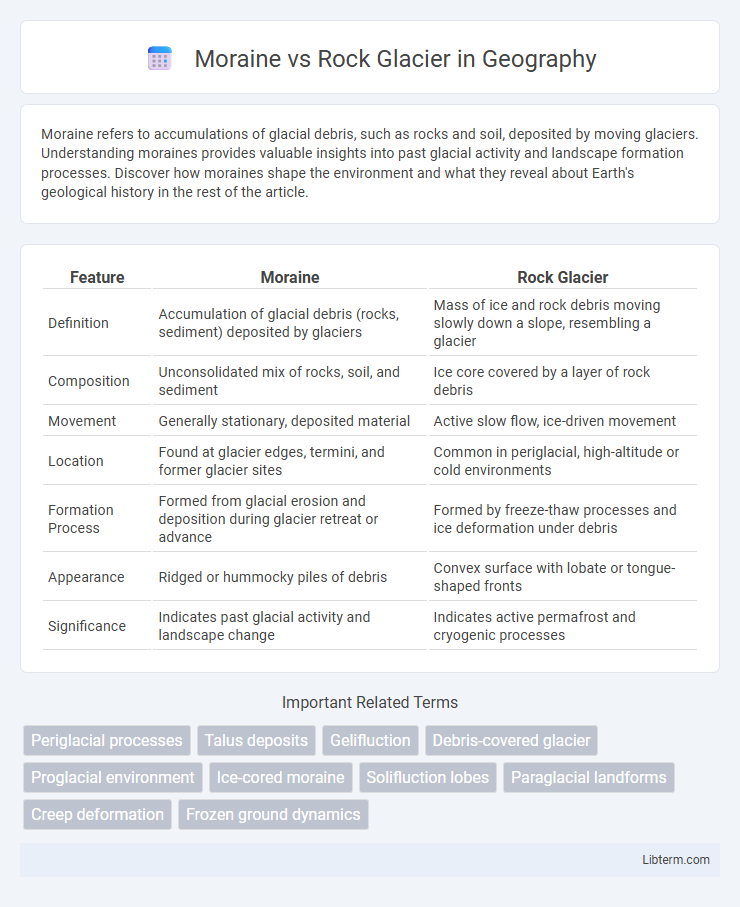Moraine refers to accumulations of glacial debris, such as rocks and soil, deposited by moving glaciers. Understanding moraines provides valuable insights into past glacial activity and landscape formation processes. Discover how moraines shape the environment and what they reveal about Earth's geological history in the rest of the article.
Table of Comparison
| Feature | Moraine | Rock Glacier |
|---|---|---|
| Definition | Accumulation of glacial debris (rocks, sediment) deposited by glaciers | Mass of ice and rock debris moving slowly down a slope, resembling a glacier |
| Composition | Unconsolidated mix of rocks, soil, and sediment | Ice core covered by a layer of rock debris |
| Movement | Generally stationary, deposited material | Active slow flow, ice-driven movement |
| Location | Found at glacier edges, termini, and former glacier sites | Common in periglacial, high-altitude or cold environments |
| Formation Process | Formed from glacial erosion and deposition during glacier retreat or advance | Formed by freeze-thaw processes and ice deformation under debris |
| Appearance | Ridged or hummocky piles of debris | Convex surface with lobate or tongue-shaped fronts |
| Significance | Indicates past glacial activity and landscape change | Indicates active permafrost and cryogenic processes |
Introduction to Moraines and Rock Glaciers
Moraines are accumulations of glacial debris composed of soil and rock fragments transported and deposited by glaciers, forming distinct landforms such as terminal, lateral, and ground moraines. Rock glaciers consist of a mixture of rock, ice, and sediment that flow slowly downslope, often found in periglacial environments with a core of interstitial ice. Both moraines and rock glaciers serve as key indicators of past and present glacial activity, reflecting geomorphological processes in alpine regions.
Definition and Characteristics of Moraines
Moraines are accumulations of unconsolidated glacial debris formed by the direct action of melting glaciers, typically consisting of rocks, soil, and sediments. Characterized by their varied shapes and sizes, moraines are classified into terminal, lateral, medial, and ground types based on their position relative to the glacier. Unlike rock glaciers, which contain a mixture of ice and rock debris, moraines primarily represent the deposited material transported and deposited by the glacier without underlying ice movement.
Definition and Characteristics of Rock Glaciers
Rock glaciers are periglacial landforms composed of a mixture of rock debris and interstitial ice, gradually flowing downslope under gravity. Unlike moraines, which consist solely of accumulated glacial debris deposited by melting glaciers, rock glaciers exhibit a lobate or tongue-like shape with a surface patterned by large-rock blocks and ridges. Their flow velocity is typically slower than true glaciers, and they act as indicators of permafrost conditions in mountainous regions.
Formation Processes: Moraines vs Rock Glaciers
Moraines form from the accumulation of glacial debris, including rocks and sediments, deposited as glaciers advance and retreat, creating ridges along glacier margins. Rock glaciers develop through the slow flow of ice-cemented rock debris, combining both permafrost ice and granular material, resulting in lobate or tongue-shaped landforms. The primary distinction lies in moraines being depositional features from direct glacial transport, while rock glaciers represent mass flow of frozen debris influenced by permafrost dynamics.
Morphological Differences between Moraines and Rock Glaciers
Moraines are accumulations of unconsolidated glacial debris formed primarily from rock and soil transported by glacier ice, characterized by their ridge-like, irregular shapes and lack of internal ice. Rock glaciers, in contrast, consist of a mixture of ice and rock debris, exhibiting lobate or tongue-shaped morphologies with a distinct flow structure due to their internal ice content. The key morphological difference lies in the active deformation and flow patterns observable in rock glaciers, unlike the mostly static, depositional form of moraines.
Geological Significance and Distribution
Moraines are accumulations of unsorted glacial debris deposited directly by glacier ice, serving as key indicators of past glacier extents and dynamics, predominantly found in alpine and polar regions worldwide. Rock glaciers consist of ice-cemented rock debris exhibiting creep movement, acting as important geomorphological markers of permafrost and cold-climate processes, commonly distributed in arid mountain environments such as the Andes, Alps, and Rocky Mountains. Both features provide valuable insights into paleoclimate reconstructions and ongoing cryospheric landscape evolution.
Climate Influence on Moraines and Rock Glaciers
Climate significantly influences moraine formation by controlling glacial advance and retreat, which deposits unsorted rock debris along glacier margins. Rock glaciers react to temperature variations and precipitation patterns by affecting the permafrost stability that supports their slow movement downslope. Understanding these climate-driven processes is crucial for interpreting landscape changes in alpine and polar environments.
Ecological Impacts and Habitats
Moraines create diverse habitats by providing nutrient-rich soils essential for plant colonization, supporting a wide range of alpine flora and fauna. Rock glaciers, composed of ice and debris, contribute to hydrological stability by slowly releasing meltwater, maintaining moisture levels critical for specialized cold-adapted species. Both landforms influence ecological succession and biodiversity patterns, but moraines typically foster more robust vegetation communities while rock glaciers sustain microhabitats crucial for cold-sensitive organisms.
Methods for Identifying and Studying Both Features
Geologists identify moraines and rock glaciers by analyzing landform morphology using remote sensing techniques such as satellite imagery and aerial photogrammetry to detect surface textures and patterns. Ground-penetrating radar (GPR) and seismic surveys are employed to study subsurface ice content and sediment structure, distinguishing the ice-rich core of rock glaciers from the sediment-dominated composition of moraines. Sedimentological analysis and dating methods like cosmogenic nuclide dating assess the age and formation processes of these geomorphological features in alpine environments.
Summary: Key Differences and Similarities
Moraines are accumulations of unconsolidated glacial debris deposited by moving ice, whereas rock glaciers consist of rock and ice masses that flow slowly down mountain slopes. Both features indicate past or present glacial activity and contribute to landscape formation through sediment transport and deposition. Moraines typically form ridges or mounds at glacier edges, while rock glaciers exhibit lobate shapes and internal ice deformation, distinguishing their structural composition and movement dynamics.
Moraine Infographic

 libterm.com
libterm.com